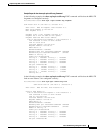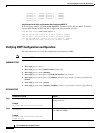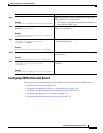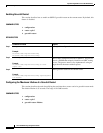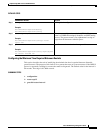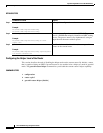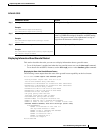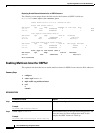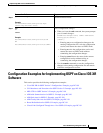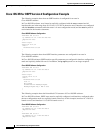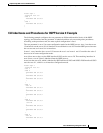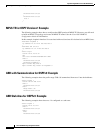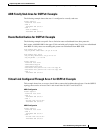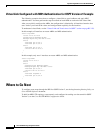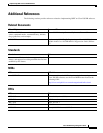
Implementing OSPF on Cisco IOS XR Software
Configuration Examples for Implementing OSPF on Cisco IOS XR Software
RC-187
Cisco IOS XR Routing Configuration Guide
Configuration Examples for Implementing OSPF on Cisco IOS XR
Software
This section provides the following configuration examples:
• Cisco IOS XR for OSPF Version 2 Configuration: Example, page RC-188
• CLI Inheritance and Precedence for OSPF Version 2: Example, page RC-189
• MPLS TE for OSPF Version 2: Example, page RC-190
• ABR with Summarization for OSPFv3: Example, page RC-190
• ABR Stub Area for OSPFv3: Example, page RC-190
• ABR Totally Stub Area for OSPFv3: Example, page RC-191
• Route Redistribution for OSPFv3: Example, page RC-191
• Virtual Link Configured Through Area 1 for OSPFv3: Example, page RC-191
Step 3
mpls traffic-eng multicast-intact
Example:
RP/0/RP0/CPU0:router(config-isis)# mpls
traffic-eng multicast-intact
Enables multicast-intact.
Step 4
end
or
commit
Example:
RP/0/RP0/CPU0:router(config-isis-af)# end
or
RP/0/RP0/CPU0:router(config-isis-af)# commit
Saves configuration changes.
• When you issue the end command, the system prompts
you to commit changes:
Uncommitted changes found, commit them before
exiting(yes/no/cancel)?
[cancel]:
–
Entering yes saves configuration changes to the
running configuration file, exits the configuration
session, and returns the router to EXEC mode.
–
Entering no exits the configuration session and
returns the router to EXEC mode without
committing the configuration changes.
–
Entering cancel leaves the router in the current
configuration session without exiting or
committing the configuration changes.
• Use the commit command to save the configuration
changes to the running configuration file and remain
within the configuration session.
Command or Action Purpose



